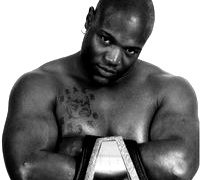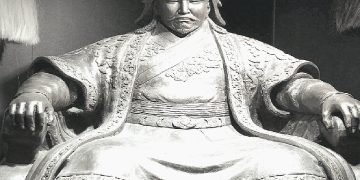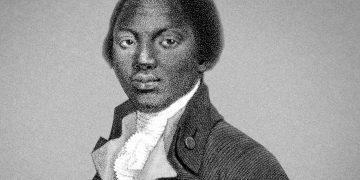The ancient Egyptian religion has come a long way in 3 thousand years and the ancient Egyptians worshiped a huge number of gods. The table also shows the most important and revered gods of Ancient Egypt.
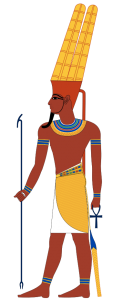 Amon (ancient Egyptian “hidden”) is an ancient Egyptian god who was worshiped in Thebes. He was portrayed as a man wearing a high crown of two feathers, sometimes with a ram’s head; sacred animals – ram, goose, snake. Since the XVIII dynasty, the supreme god (in identification with Ra – Amon-Pa), the patron saint of royal power and wars of conquest. Together with Amon, the so-called Theban triad is formed by his wife, the goddess Mut (ancient Egyptian “mother”) and his son, the moon god Khonsu (ancient Egyptian “wandering”).
Amon (ancient Egyptian “hidden”) is an ancient Egyptian god who was worshiped in Thebes. He was portrayed as a man wearing a high crown of two feathers, sometimes with a ram’s head; sacred animals – ram, goose, snake. Since the XVIII dynasty, the supreme god (in identification with Ra – Amon-Pa), the patron saint of royal power and wars of conquest. Together with Amon, the so-called Theban triad is formed by his wife, the goddess Mut (ancient Egyptian “mother”) and his son, the moon god Khonsu (ancient Egyptian “wandering”).
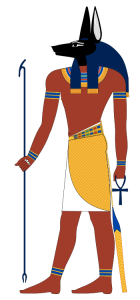 Anubis is an ancient Egyptian god, in the III millennium BC, before the spread of the cult of Osiris, a deity of the afterlife. Later – the deity of the circle of Osiris as the lord of the dead, the patron saint of the funeral ritual. The sacred animal is a black jackal, with the head of which he was depicted. The center of the cult is the city of Kinopol.
Anubis is an ancient Egyptian god, in the III millennium BC, before the spread of the cult of Osiris, a deity of the afterlife. Later – the deity of the circle of Osiris as the lord of the dead, the patron saint of the funeral ritual. The sacred animal is a black jackal, with the head of which he was depicted. The center of the cult is the city of Kinopol.
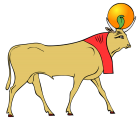 Apis – a sacred bull of black and white color revered in ancient Egypt, which was considered the earthly repository of the god of fertility Osiris-Hapi, was kept and buried after death in his temple in Memphis.
Apis – a sacred bull of black and white color revered in ancient Egypt, which was considered the earthly repository of the god of fertility Osiris-Hapi, was kept and buried after death in his temple in Memphis.
Aton (ancient Egyptian “solar disk”) is an ancient Egyptian god who was worshiped in the form of the sun visible in the sky. Known from the Middle Kingdom; under Amenhotep IV (Akhenaten) – the central figure of the religious reform carried out by him (the only god, the supreme ruler of the world, having the title of Pharaoh, and the father of Akhenaten).
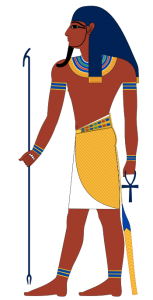 Atum (ancient Egyptian “complete, complete” or “nonexistent”) – the ancient Egyptian god-demiurge, worshiped in the city of Heliopolis. After identification at the beginning of the 5th Dynasty with the god Ra, he acquired the aspect of a solar deity.
Atum (ancient Egyptian “complete, complete” or “nonexistent”) – the ancient Egyptian god-demiurge, worshiped in the city of Heliopolis. After identification at the beginning of the 5th Dynasty with the god Ra, he acquired the aspect of a solar deity.
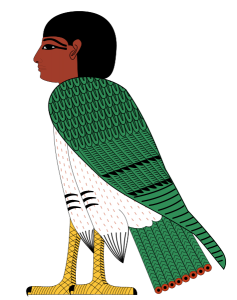 Ba – in the ancient Egyptian concept of “power”, the physical life energy of a person. According to the beliefs of the Egyptians, the soul-Ba consisted of a set of feelings and emotions of a person. Variability was attributed to Ba; in addition, it was believed that it is closely related to other shells and directly depends on the state of the physical body. During the life of the body, the ba traveled through the world of dreams. He could move freely between the world of the dead and the living. Soul-Ba could also migrate to other bodies at the request of its owner. After the death of a person, she was next to the heart while weighing it, then, according to the Egyptians, she fell into a lethargic sleep.
Ba – in the ancient Egyptian concept of “power”, the physical life energy of a person. According to the beliefs of the Egyptians, the soul-Ba consisted of a set of feelings and emotions of a person. Variability was attributed to Ba; in addition, it was believed that it is closely related to other shells and directly depends on the state of the physical body. During the life of the body, the ba traveled through the world of dreams. He could move freely between the world of the dead and the living. Soul-Ba could also migrate to other bodies at the request of its owner. After the death of a person, she was next to the heart while weighing it, then, according to the Egyptians, she fell into a lethargic sleep.
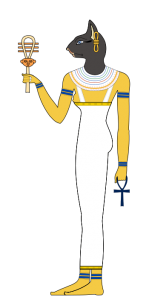 Bastet is the ancient Egyptian goddess of love and fun, worshiped in the city of Bubastis. A sacred animal is a cat, with the head of which she could be depicted.
Bastet is the ancient Egyptian goddess of love and fun, worshiped in the city of Bubastis. A sacred animal is a cat, with the head of which she could be depicted.
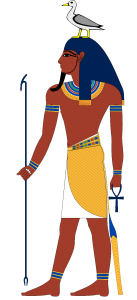 Geb is the ancient Egyptian god of the earth, the son of Shu and Tefnut, brother and husband of Nut and the father of Osiris, Isis, Set and Nephthys. Was the God of the Earth or the Earthly Hill. Cosmogonic myths portrayed him as being in eternal conjunction with the goddess of the sky Nut, until the god of air Shu separated them. In the texts of the pyramids, he is also credited with protecting the dead. He was depicted as an old man with a beard and royal ornaments or stretched out in full length, with Nut leaning on him, supported by Shu.
Geb is the ancient Egyptian god of the earth, the son of Shu and Tefnut, brother and husband of Nut and the father of Osiris, Isis, Set and Nephthys. Was the God of the Earth or the Earthly Hill. Cosmogonic myths portrayed him as being in eternal conjunction with the goddess of the sky Nut, until the god of air Shu separated them. In the texts of the pyramids, he is also credited with protecting the dead. He was depicted as an old man with a beard and royal ornaments or stretched out in full length, with Nut leaning on him, supported by Shu.
Isis – the ancient Egyptian goddess, originally associated with royal power and personifying the throne; later included in the cult of Osiris as his faithful wife and selfless mother Horus. Thus, she personified the ideal of femininity and motherhood. She is also known as the protector of the dead and the patron goddess of children. In Hellenistic times, the cult of Isis from Egypt spread throughout the ancient world.
Maat (ancient Egyptian “truth”) is a fundamental concept of the Egyptian worldview, which means a cosmological / social order maintained by the supreme god and pharaoh as opposed to the tendencies of chaos (“isfet”). She personified truth, justice, universal harmony, divine institution and ethical norm; Common Egyptian goddess (depicted with a feather on her head).
Ka – in ancient Egyptian ideas, an objectively existing visible image of a person and, in principle, any creature and object that arises with him, accompanies him throughout his life and remains after his death (destruction) in the memory of people and images. “Preserving the ka” of the deceased by creating his accurate images is one of the main ways of magically maintaining his posthumous existence. “Ka” was portrayed as a semblance of its bearer, but with arms raised up.
Montu is the ancient Egyptian warrior god, patron of the pharaoh’s military successes. He was depicted with the head of a falcon and was revered in the city of Hermont and the city of Thebes, where he was later ousted from the leading place in the cult by Amon.

